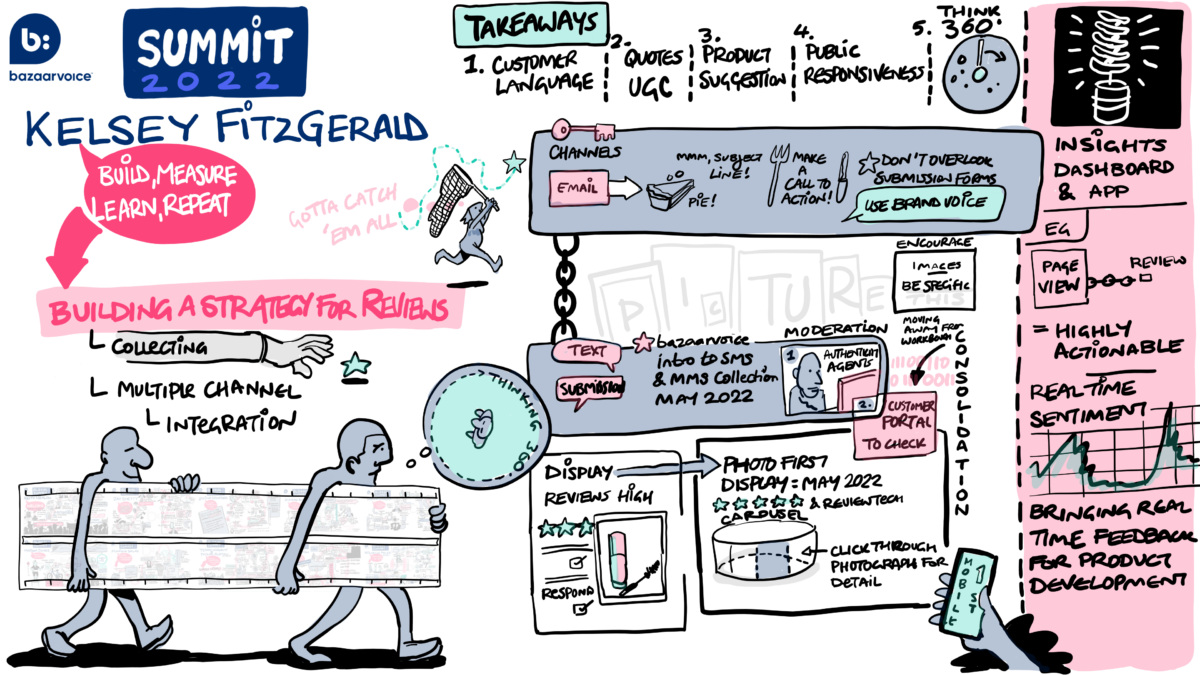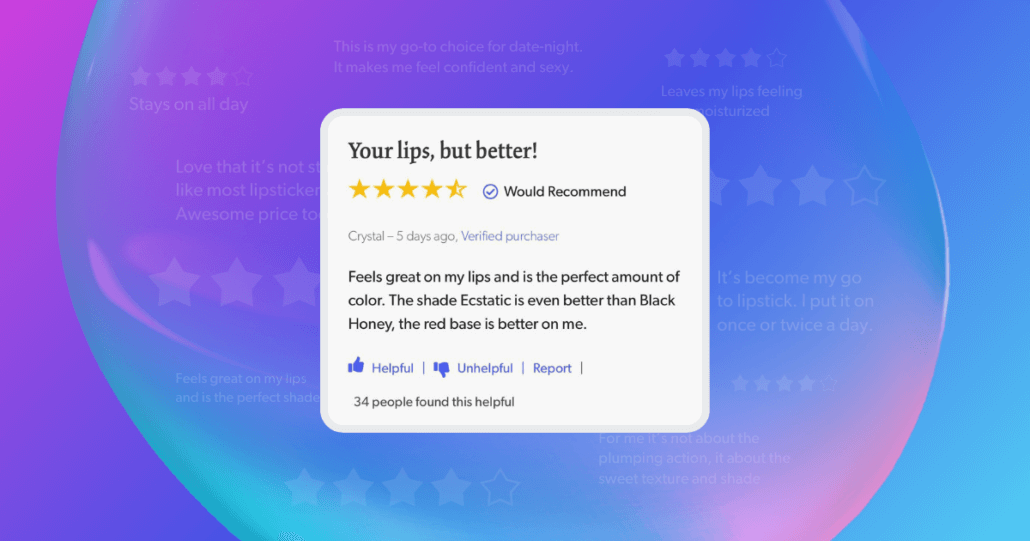April 7, 2022
These are live-blogged notes and sketches from a Bazaarvoice Summit session, delivered by Kelsey Fitzgerald, Lead Client Success Manager at Bazaarvoice, on April 7th, 2022. The rest of our Summit content can be found here.
In her session, Kelsey covered a whole range of awesome topics around making the most of your ratings and reviews program. Let’s kick off with the first step in the process: collecting them.
Collect ratings and reviews
If there’s one thing that’s certain it’s that no two customer journeys are the same. You need to consider a whole range of channels, and how you’ll collect reviews from them:
- Directly on your site
- Sampling
- Product communities
- In your physical store
- Social media
- Sweepstakes
- SMS
- Events
This list is only going to grow. You need to think about your collection strategy from this holistic viewpoint from now on.
Email collection
Email remains one of the most prominent channels for getting in contact with customers. 1.2 billion emails were sent to customers in 2021 via Bazaarvoice — that’s pressure testing! It means we have some of the best insights into how to get the reviews you need.
For example, our in-email tools ensure you maximize the returns from your emails, by allowing customers to submit their reviews without having to leave their mail app — that means many more reviews for you!
What are the best practices for your post-interaction emails (PIE)?
- Make sure your subject line is a call to action, rather than a thank you, which can be mistaken for a purchase receipt
- Leave time for them to actually use the product — that’s going to vary from product to product
- Switch up subject lines, and compare the impact on collection
- Don’t forget to follow up, saying “We’re still waiting for a review” — 10 days is often a good period
Making the most of your PIE submission form
The submission form should be written in your brand voice, and do use the prompt text to suggest the kinds of reviews you’d like them to leave. Getting the prompt right will get you better marketing content. Use the words in the prompt that you want them to use. Add questions about the shopper that will allow other shoppers to understand that the reviewer is like them in significant ways — we have tools that allow you to show these via filters.
And make sure you give them the option to include a photo. Visual content is growing ever more important. Suggest that they show the results of product use — clear glossy hair, a meal cooked with your product — not the product itself.
If you’re getting too many damaged product photos, rework your PIE to direct those elsewhere, and then you’ll capture appropriate product photos through this process.
Changing the elements of the PIE is really low-hanging fruit you can go and do now in the copy editor. The submissions form editor allows you to add those personalized filter variables.
Text message capture
Customers are coming to see texts from businesses as commonplace, with 62% of consumers subscribing to receive texts from a business in the last year. Retail is only just behind in customer expectation of contact via text.
Great news: We’re about to release text message submission of reviews! Our initials tests show that we get twice as many reviews via text message than via email. We’ll release it in May and give you more details then. You’ll be able to collect photos and videos through the standard hosted platform through this method, not just text.
Managing ratings and reviews
The first line of any strategy for managing reviews is authenticity and moderation. Our tools will help you do that — using rules and scoring models to reject possibly inappropriate content, or queue it for review. We moderate all the content coming in with industry-specific guidelines.
The second layer after moderation and authenticity is your view on what we’ve accepted or rejected. You can manually approve or reject reviews, and you can directly respond if you wish. We have a modern, clean Portal for doing this. We’re moving clients away from Workbench to Portal from Summer 2022 onwards — and we think you’ll love it.
Display ratings and reviews
Are you including ratings for your product on category-level pages? Customers love seeing ratings before they click through to product pages. Have you captured data that allows shoppers to filter by important reviewer characteristics, like hair color or location? Are you using review highlights to surface themes within the reviews?
Do consider responding to reviews. The sight of you responding to issues can make a big difference to people adding products to your cart.
More exciting news: We’ll launch our new photo-first display for our hosted product display in May. It has an improved carousel, we’ve made filters display by default, and replaced the “write a review” button with a star rating button, which eases customers into the review process. The progressive approach allows you to capture reviews even if they don’t complete the whole process.
And talking of progressive approaches, progressive loading of product display components makes it even more mobile-friendly for the shopper.
We do have a review translation feature via Google Translate. If it’s enabled, it appears in the native language, with a button to display the translated review.
Measure results
The collection dashboard within the Insight tool is a great place to start measuring your results. It can help surface things that need attention. Like if you’re getting lots of customer service rejections, you may need to be more transparent in your instructions on where they can go with customer service complaints..rather than put them in a review.
We really recommend you play around with the app to discover what great content is there. For example, one incredibly useful tool is data about coverage. One view will show you high-traffic pages with low volumes of reviews. You can concentrate on using tactical approaches to develop these review volumes to turn shoppers into buyers.
Learn from suggestions from within the reviews and send them onwards to your product and marketing teams. For example, one makeup brand ended up creating a travel size line, prompted by reviews they collected through us.
Listening to customers can help shape your next steps in product development.
The Insights tools also allow you to see how you’re performing against the industry as a whole, and you can upgrade to our premium product to compare yourself against named competitor brands.
Learn from your ratings and reviews program
Always be on the lookout for learning opportunities. You essentially have a focus group at your fingerprints through the reviews. Have the customer used keywords you should put into your product description? Are they talking about packaging or sizing issues that need to be addressed?
You can identify positive reviews to amplify in a marketing campaign — and also the negative ones you need to respond to. And don’t forget to respond to positive ones, too. That’s a great experience for an already happy customer.
Key takeaways
- Take a holistic approach to ratings and review collection
- Manage your content at-scale through the right combination of automation and manual control
- Make it easy for shoppers to consume UGC on your site
- Measure the performance of your ratings and reviews program consistently and be on the lookout for learning opportunities
The retail industry is as strong as ever. And consumers hold the power like never before. They decide how a brand is perceived, and the risk of boycott in today’s cancel culture is very real. The dramatic power shift to customers has led to heightened actions and vocalizing for authenticity, improved experiences, and above all, for consumers to feel heard. Catch up on Bazaarvoice Summit to see how to win hearts and minds of today’s consumers.









